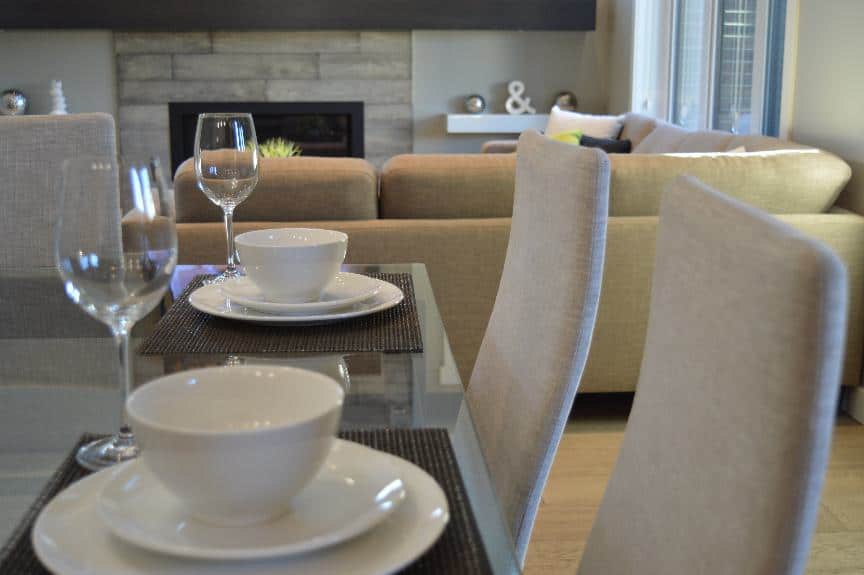You can place a dining table in the living room to save space, especially in smaller homes.
It's important to choose a table that matches the living room's style and to arrange it in a way that doesn't block the flow of the room.
This setup should allow for both relaxation and dining, making the living room more versatile.
Assessing Your Space
Measure your living room to see if you can fit a dining table without affecting its use or movement. For tight spaces, careful planning is important. Choose a small dining table that fits well with the rest of the room.
Start by measuring the space, making sure there's enough room to walk around furniture. An open floor plan gives you more options, while a smaller room might need more creative solutions. Opt for dining chairs that fit under the table to save space and keep walkways clear.
Place an area rug to visually separate the dining area from the living space. This creates a cozy dining spot without physical barriers. Make sure the rug is big enough for the chairs to sit on it even when pulled out to prevent a cluttered look and tripping.
A bistro table is a good option for very small spaces, offering a place to eat daily and host small gatherings. The goal is to balance function and design, creating a comfortable and stylish multi-use area.
Choosing the Right Table
When selecting a dining table, ensure it matches the size and style of your living room. A functional table can act as a focal point, provide guest seating, and be used for work. In small rooms, choose a table that fits comfortably. In larger spaces, verify that there's enough clearance around the table. The table should coordinate with other furniture and maintain a well-proportioned layout.
Choose materials that complement your living room. Light-reflecting surfaces like glass can make a space feel larger, while wood offers warmth and sturdiness. For tight spaces, extendable or space-saving tables are practical.
The dining area should form a cohesive part of the living room. Use rugs to define the space, and lighting, such as a chandelier, to indicate its purpose. Decorative items like artwork and shelving can enhance the dining experience.
The chosen table should suit your taste and the functionality of your room, providing a comfortable setting for meals and social events.
Furniture Arrangement Tips
To effectively use a combined living and dining area, proper furniture placement is essential. Defining the dining section with a rug can visually separate it from the living area and add comfort. Ensure ample space around the dining table for easy movement. Chairs that fit under the table, such as compact or rolling chairs, help conserve space and maintain ease of use.
Lighting is important for setting the dining area apart. A pendant lamp above the table provides focused light and helps distinguish the dining space from the rest of the room.
In small spaces, a bistro table or a compact table with stools can be placed next to stairs to utilize space efficiently. This maintains the openness of the room while providing a distinct dining area. Thoughtful furniture arrangement can create a balanced space that accommodates both living and dining functions.
Multi-Functional Design Ideas
A dining table in the living room serves both practical and design purposes. Homes today often combine living and dining areas for a more flexible layout.
Furniture can be arranged to allow the dining table to also be a place for games and movies, making it a central part of daily life.
Choosing compact chairs that fit under the table helps keep the room spacious. A dining spot can also be set up in a sunny corner with benches to save space and enhance the room's look.
A rug can define a dining area within the living room, creating a separate space that still fits with the overall decor. Replacing a formal dining set with a bistro table in the kitchen can also save space and allow for a more adaptable living area.
Decorative Elements Integration
Integrating a dining table into a living room can be aesthetically pleasing and functional. A chandelier placed above the table can mark the dining area and provide focused lighting, adding elegance to meals.
Artwork can visually separate the dining zone from the living space, especially when it matches the dining set's style and color. Placing the dining area near a window utilizes natural light and enhances the ambiance without structural changes.
A rug under the dining table can define the space while adding comfort and texture. Choosing adaptable furniture allows the dining area to blend with the living room, serving multiple purposes and maintaining visual harmony.
Maintaining Traffic Flow
To ensure smooth movement in a combined living and dining space, it's important to arrange the area so it doesn't block pathways. The dining table should be positioned away from main walkways. Using compact chairs and L-shaped benches can help save space and keep pathways open.
Placing a rug under the dining table can help visually separate the dining area from the living space, directing foot traffic around rather than through the area. It's also vital to arrange accents and furniture to clearly define the dining space while keeping an open feel.
Proper furniture placement with adequate space for walking is key to enjoying a functional and comfortable combined space. Strategic design choices facilitate clear traffic flow and contribute to the room's overall functionality.





